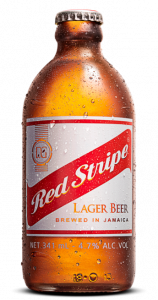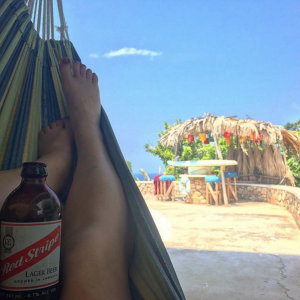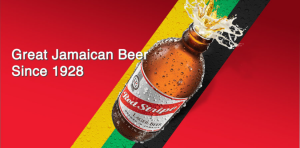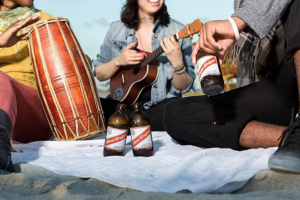43 Red Stripe
Introduction
Red stripe is an award-winning beer that embodies the lively spirit of Jamaica. A pale amber lager that showcases the island vibes of the Caribbean. While the beer recipe was originally developed in the United States it is synonymous with Jamaican culture. Its flavour is derived from Pilsen malt, hops, cassava starch, and water. Red Stripe offers smooth butterscotch notes with a 4.7 alcohol level (Red Stripe, 2020) Red Stripe is the official sponsor of international sporting events such as the Cricket World Cup and has played a pivotal role in sponsoring the Jamaican Football Federation’s efforts to qualify in the FIFA World Cup. Red Stripe has also sponsored the Jamaica national bobsled team who first debuted in the 1988 Winter Olympic Games in Calgary, Alberta (Wikipedia, 2020) Music festivals have also played an integral role in highlighting the Red Stripe brand’s popularity (Red Stripe, 2020). Supporting the underground music scene while increasing its consumption with beer drinkers worldwide. Red Stripe has sponsored The Great Escape, Reggae Sumfest, and Camden Crawl festivals (Wikipedia, 2020). Red Stripe is widely recognized with its distinct stubby bottle and a diagonal red stripe on the label. In 2015 Red Stripe was acquired by Heineken (SpruceEats, 2018).

Red Stripe (n.d.) Retrieved from https://redstripebeer.com/our-beer/
Origins
Red Stripe was originally brewed in Illinois, USA by the Galena Brewing Company. Under financial pressure during the great depression the Galena Brewing Company sold the beer recipe to two British friends named Thomas Hargreaves Geddes and Eugene Desnoes. The two entrepreneurs shared a dream and a lasting partnership of 79 years. (Jamaica Gleaner, 2018). In 1918 the Desnoes and Geddes Company Limited was officially formed. Better known as D&G, the company created the first brewery in Kingston, Jamaica. Their dream came to fruition and Red Stripe was officially branded in 1928 (Red Stripe, 2020). The first Red Stripe beer was a dark ale with traditional British influences. In 1938 Paul Geddes, the son of Thomas H. Geddes and Peter Desnoes, the son of Eugene Desnoes took over the family owned business (Red Stripe, 2020). They later crafted the golden lager that is enjoyed today. Over the years many tourists and Jamaicans alike have grown to appreciate the crisp and refreshing lager (Beer Syndicate, 2018). Due to the warm tropical climate in Jamaica, the Red Stripe beer evolved to suit local tastes. The traditional British style of brewing ale held fuller bodied, rich and robust characteristics. The lager replaced the local demand for a more smooth and thirst-quenching beer under the hot Caribbean sun.

Red Stripe (n.d.) Retrieved from https://redstripebeer.com/passions/experiences/#images-4

Riverside Bartending School (n.d.) Retrieved from https://www.riversidebartendingschool.com/red-stripe-beer/
Milestones
- In 1928 the first Red Stripe branded beer was introduced to the world. The Red Stripe brewery became a source of national pride for Jamaicans (Red Stripe, 2020)
- The Red Stripe brewery reformulated their beer recipe in 1938. A new lighter tasting pale lager was introduced with great success (Red Stripe, 2020)
- Jamaica gained independence from Britain in 1962 . This led to increased consumer consumption (Red Stripe, 2020)
- In 1965 Red Stripe introduced their world famous stubby bottle (Red Stripe, 2020)
- Imported ingredients like high maltose corn syrup were replaced by locally grown cassava root changing Red Stripe’s flavour profile (Inter-American Development Bank, 2020)
- In 1970 Desnoes & Geddes achieved success and became a publicly traded company (Red Stripe, 2020)
- In 1993, Guinness, also known as Diageo acquired 51% ownership of Desnoes & Geddes Limited. The acquisition increased Red Stripe distribution on an international scale (Wikipedia, 2020)
- In 2003 Red Stripe won a gold medal in the Monde Selection Quality Awards (Red Stripe, 2020)
- Red Stripe exported more beer to other countries than their domestic local consumption in 2005 (Red Stripe, 2020)
- In 2015 Heineken purchased Red Stripe and publicly promised to bring all brewing operations back to Jamaica (SpruceEats, 2018)
Brewing Science and Industrialization
Refined bauxite is used to make aluminum cans which was the premiere choice of beer storage by major breweries. Canning expanded the mass production of beer which in turn increased distribution. The discovery of bauxite was very pivotal for the Jamaican economy as it allowed the government to concentrate on stimulating industrial development. (The New York Times, 1964). Bauxite mining attracted foreign investment from Canada, USA, and Britain. (The New York Times, 1964) The opaque nature of cans enables beer preservation because of its resistance to sunlight. UV rays create a photo-oxidation in hops which negatively affects the flavour profile of beer. (The Atlantic, 2016) New brewing science technologies paved the way for the Red Stripe brand to experiment with local agriculture and partner up with local farmers. These partnerships contributed to the Jamaican economy and benefited local communities with employment opportunities. (Inter-American Development Bank, 2020) Cassava root was introduced to the recipe formulation of Red Stripe beer and replaced imported ingredients like high maltose corn syrup. The Red Stripe brewery thus saved import fees by taking advantage of locally grown crops. (Inter-American Development Bank, 2020) Reformulating proved to be economically successful for the brand through cost efficiency measures.
Beer Style
Red Stripe was initially established as an ale showcasing traditional British influences as Thomas Hargreaves Geddes and Eugene Desnoes were both British entrepreneurs. (Jamaica Gleaner, 2018) The first Red Stripe beer held all the robust flavour characteristics typically enjoyed in the colder climate of Europe. Red Stripe was originally a darker, heavier, and richer ale. Ales prefer a warmer serving temperature for consumption in order not to compromise taste. In 1938 Paul Geddes, the son of Thomas H. Geddes and Peter Desnoes, the son of Eugene Desnoes took over the family owned business (Red Stripe, 2020) The Red Stripe brewery began its evolutionary process towards introducing bold new changes to their beer recipe. (Jamaica Gleaner, 2018) Since Jamaica is situated in the Caribbean the demand for a crisper lighter beer was in accordance with its warm, sunny, and humid weather. Red Stripe was reformulated as a lager to meet local consumer demand. Red Stripe emerged as a smooth tasting lager which is bottom fermented at cooler temperatures. Lagers are more thirst quenching in nature and taste best served under colder temperatures. The refreshing quality of Red Stripe’s golden lager is celebrated as the undisputed king of lagers in every corner of Jamaica. (Beer Syndicate, 2018) Jamaica’s signature beer is recommended served cold. (Red Stripe, 2020)
Red Stripe beer is best enjoyed in a tall frosted glass that showcases its pale amber colour while retaining carbonation. This type of glass also preserves the beer’s head.
Singleton, I (2010, March 10), Day Seventy Four, Retrieved from https://www.flickr.com/photos/isaacsingleton/4437358204/
The WW1 and WW11 Era
World War 1 occurred before the creation of the Red Stripe brand but WW11 had a significant impact on the brewery. Jamaica as a British colony was immediately involved in World War 11 after Britain declared war on Germany. (Wikipedia, 2020) Jamaican troops also known as the Jamaica Defence Force served alongside the British Army’s West India Regiment. (Wikipedia, 2020) Manufacturing suffered with a reduced work force. Due to the war, commodities were heavily regulated by Britain. Importing ingredients to brew Red Stripe saw sharp price increases thus slowing production. It was in 1938 that Red Stripe reformulated their recipe to cut costs. The brewery sought locally grown ingredients to replace the more expensive imports. Labour shortages also slowed beer manufacturing as the remaining amount of Jamaican workers began strikes protesting labour conditions. (Wikipedia, 2020) Jamaica was also an important source for bauxite, the material needed to make aluminum cans. Bauxite was exported to aide aircraft production during the war. Post WW11 brought significant changes to Jamaican manufacturing as Canada and the USA replaced Britain as trading partners. (The New York Times, 1964) Jamaican independence from Britain followed in 1962 with full dominion status under the commonwealth. (Red Stripe, 2020) Red Stripe sponsors various celebrations as part of Jamaica’s Independence Day festivities. (Red Stripe, 2020)

Red Stripe is enjoyed by party revelers during musical performances, parades, and arts exhibitions.
Red Stripe (n.d.) Retrieved from https://redstripebeer.com/passions/experiences/#images-16
Consolidation and Globalization
- Red Stripe was originally brewed in Kingston, Jamaica by Desnoes and Geddes Limited. (Red Stripe, 2020)
- In 1993, 51% percent of the ownership of Red Stripe was purchased by the Guinness Brewery (Wikipedia, 2020) This acquisition played a very significant role in increasing its distribution globally.
- In 1997, Guinness merged with Grand Metropolitan. (Beer Syndicate, 2018) This merger resulted in the formation of Diageo, a British multinational company. Diageo became the new owner of Red Stripe.
- In 2012, Diageo partially moved brewing operations to the USA. This cost cutting measure was only done for production intended for the American market. Production for Jamaica, Brazil, Canada, and Europe stayed in Jamaica. (SpruceEats, 2018)
- In 2015 Heineken purchased Diageo’s shares in Red Stripe. Heineken also owns a collection of up to 170 other beer brands. (Beer Syndicate, 2018) Heineken subsequently promised to bring all brewing operations back to Jamaica. (SpruceEats, 2018)
Marketing and Branding
When people think of sunny beaches and reggae music a cold crisp Red Stripe comes to mind. Red Stripe beer makes you think of a good time in the tropics. Red Stripe launched a popular ad campaign in 2001 intended for a North American audience. (Wikipedia, 2020) The advertisement starred Dorrel Salmon who played upon a comedic take on a Jamaican catch phrase, “Hooray, beer!” (Wikipedia, 2020) Catch phrases such as “easy now” were targeted to a British audience. (Wikipedia, 2020) The red stripe on their logo sets the beer apart from other brands. The most distinguished feature of Red Stripe is their dark stubby bottle which was introduced in 1965. (Red Stripe, 2020) Their branding is incorporated into their marketing because the bottle stands out when being consumed. Through strategic sponsorship of their national sports teams and music venues their beer appeals to every demographic. The brand and marketing has a patriotic focus which instantly reflects Jamaica’s national pride. Cultural influences within the marketing strategy encourages brand loyalty. Red Stripe even states that their brand is synonymous with all things Jamaican. (Red Stripe, 2020) The beer projects a relaxed island vibe and Caribbean flavour. Jamaica is famous for its jerk chicken partnered with a cold Red Stripe beer.
Red Stripe, Youtube, 2019, Sorrel Flavoured Jerk Chicken, Chicken and Beer (Online Video) Available from https://www.youtube.com/watch?v=mR9TDM0g-wU#action=share
Modern Era
Red Stripe is moving forward into the modern era with strategic changes after being purchased by Heineken. (Red Stripe, 2020) It is an exciting time for the brewery as Heineken has committed to a long-term investment market plan to further establish the brand’s presence internationally. In 2016, Heineken returned the entirety of Red Stripe’s production back to Jamaica recognizing its heritage as an authentic Jamaican beer.( Beer Syndicate, 2018) Red Stripe’s historical past as the first brewery with Jamaican roots helped shape their brand image. Recognizing consumer trends and tapping into the increased demand for imported beer they invested $16 million into new cutting-edge manufacturing equipment.(Fooddive, 2018) Red Stripe is poised to boost production and increase distribution worldwide. The brewery has also followed social trends by embracing environmental initiatives. Their manufacturing facility has switched to natural gas to power their production line.(Fooddive, 2018) This move alone will offer a reduction in fuel usage lowering their carbon footprint. Red Stripe will have a significant reduction in greenhouse emissions. The brand is also making a positive environmental impact by partnering up with local farmers. (Inter-American Development Bank, 2020) Working with the local agricultural community offers a tremendous boost to the Jamaican economy by providing employment opportunities. (Inter-American Development Bank, 2020) Poised for growth via a greener planet and creating delicious beer. Tourism has also contributed to Red Stripe’s success with travellers seeking new adventures under the hot Caribbean sun while enjoying Jamaica’s coastal beaches. Tourists explore new cultural experiences and discover new culinary treats paired with Jamaica’s very own Red Stripe beer. Social media has also played a pivotal role in growing Red Stripe’s international presence. The brand sponsors many events and showcases the culture behind their beer.(Wikipedia, 2020) The brewery has increased their exposure and is able to reach a diverse audience. New digital platforms allow consumers to share and discover what the brand is all about.
References
Byrne, Brendan, (2016), The Rise of the Beer Can (Online article). Retrieved from https://www.theatlantic.com/technology/archive/2016/05/rise-of-the-beer-can/484406/
Chew, Cassie (2018), Heineken looks to grow sales of Red Stripe following $16M investment (Online article). Retrieved from https://www.fooddive.com/news/heineken-looks-to-grow-sales-of-red-stripe-following-16m-investment/514764/
Eddings, Bryce. (2018). What You Need to Know About Red Stripe Lager (Online article). Retrieved from https:// thespruceeats.com/red-stripe-jamaican-lager-review-352989
History of Desnoes and Geddes. (2018, July 9). The Jamaica Gleaner. Retrieved from https://jamaica-gleaner.com/article/news/20180709/history-desnoes-geddes
History of Red Stripe. (n. d.). Retrieved from https://www.redstripebeer.com/heritage/
Jamaica’s Beer Infused Recipe for Development, (n. d.), Retrieved from https://www.iadb.org/en/improvinglives/jamaicas-beer-infused-recipe-development
Jamaica Pushes Industrial Aims, (1964, January 17), The New York Times, Retrieved from https://www.nytimes.com/1964/01/17/archives/jamaica-pushes-industrialization-aims.html
Leonard, Daniel J. (2018, January 31). A Guide to the Jamaican Beer Scene. (Web blog post). Retrieved from https://beersyndicate.com/blog/tag/history-of-red-stripe/
(2020), Wikipedia, Retrieved from https://en.wikipedia.org/wiki/Jamaica
(2020). Wikipedia. Retrieved from https://en.wikipedia.org/wiki/Red_Stripe


